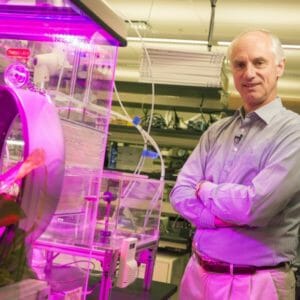A key component of ambient direct air capture (DAC) systems that remove carbon dioxide from the air is the sorbent material that is used to first capture the carbon and then to release it. Certain sorbent materials can pull carbon dioxide from the air as it flows over the material. It then releases the carbon when water is applied. As the material dries again, it absorbs carbon, and so on.
This elegant function of specific materials has been observed for several years by those working on DAC systems, like Klaus Lackner, sustainability scientist and professor in the School of Sustainable Engineering and the Built Environment. Lackner has developed a system called “MechanicalTree” that uses sorbent materials to remove carbon from air.Klaus LacknerKlaus Lackner in his lab. New research by Lackner and his colleagues explains how sorbent materials catch and release carbon, a key component to direct air capture systems that remove carbon from the atmosphere.
Now, in a new paper in the early, online edition of Joule, Lackner and his colleagues lay out exactly how some of these sorbent materials capture and release carbon, a finding that could lead to the smarter design of sorbent materials at the heart of all carbon removal systems.
A summary follows:
An energy-saving system containing ion-exchange or nanoporous materials and carbonate ions is proposed, which is capable of capturing CO2 from ambient air simply by controlling the amount of water (moisture) in contact with the sorbent. The system binds CO2 from the air when the surrounding is dry, whereas it desorbs CO2 when it is wet. A design of such CO2 sorption and desorption systems is investigated using quantum mechanics simulations and is verified by experiments. Its working mechanism is revealed as the free energy change of the chemical reaction of the carbonate ions and water molecules; the free energy change decreases when the number of water molecules in the materials decreases. The influence of pore size, spacing of cations, and surface hydrophobicity of the sorbents on CO2 capture efficiency are elucidated. The study sheds light on ways to optimize an efficient direct air capture system and therefore contributes to the development of “negative emission technologies.”
